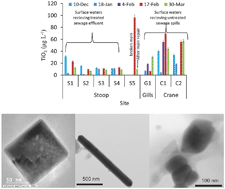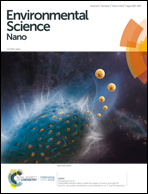Sewage spills are a major source of titanium dioxide engineered (nano)-particle release into the environment†
Abstract
Sanitary sewer overflows (SSOs) are a common problem across the United States. An estimated number of 23 000–75 000 SSOs occurred in 2004, discharging between 11 and 38 billion liters of untreated wastewater to receiving waters. SSOs release many contaminants, including engineered nanomaterials (ENMs), to receiving water bodies. Measuring ENM concentrations in environmental samples remains a key challenge in environmental nanotechnology and requires the distinction between natural and engineered particles. This distinction between natural and engineered particles is often hampered by the similarities in the intrinsic properties of natural and engineered particles, such as particle size, composition, density, and surface chemistry, and by the limitations of the available nanometrology tools. To overcome these challenges, we applied a multi-method approach to measure the concentrations and properties of TiO2 engineered particles (e.g., ENMs and pigments) including: 1) multi element-single particle-inductively coupled plasma-mass spectrometry (ME-SP-ICP-MS) to identify elemental associations and to determine elemental ratios in natural particles, 2) calculation of total elemental concentrations and ratios from total metal concentrations measured following total sample digestion to estimate engineered particle concentrations, and 3) transmission electron microscopy (TEM) to characterize engineered particle size and morphology. ME-SP-ICP-MS analysis revealed that natural TiO2 particles are often associated with at least one of the following elements: Al, Fe, Ce, Si, La, Zr, Nb, Pb, Ba, Th, Ta, W and U, and that elemental ratios of Ti to these elements, except Pb, are typical of riverine particulates and the average crustal ratios. High TiO2 engineered particle concentrations up to 100 μg L−1 were found in SSO-impacted surface waters. TEM analysis demonstrated the presence of regular-shape TiO2 particles in SSO-impacted surface waters. This study provides a comprehensive approach for measuring TiO2 engineered particle concentrations in surface waters. The quantitative data produced in this work can be used as input for modeling studies and pave the way for routine monitoring of ENMs in environmental systems, validation of ENM fate models, and more accurate ENM exposure and risk assessment.



 Please wait while we load your content...
Please wait while we load your content...